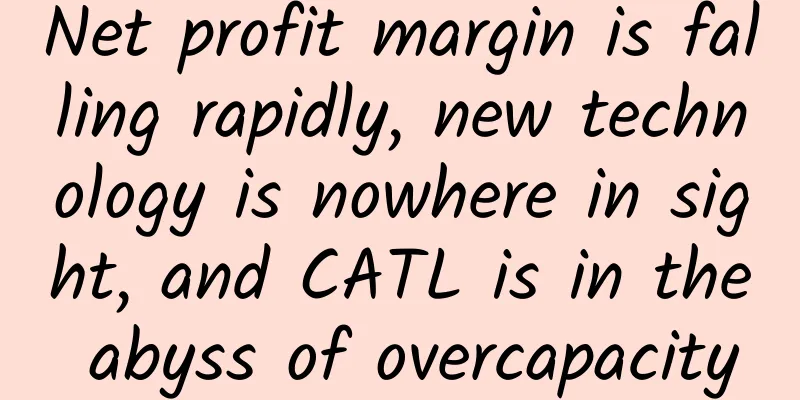Net profit margin is falling rapidly, new technology is nowhere in sight, and CATL is in the abyss of overcapacity

|
On May 31, CATL, which was established only six years ago, was officially listed on the Shenzhen Stock Exchange with the halo of a "unicorn". It was once the most popular company, with the subscription multiple reaching 1,067 times and the winning rate being only 0.093736%. This is not the first time that CATL has surprised people. In March this year, the "2017 China Unicorn Enterprise Development Report" released by the Ministry of Science and Technology showed that CATL has surpassed Panasonic to become the world's number one power battery company in terms of sales. In the domestic market, BYD and CATL share about 44% of the national power battery market share, of which CATL accounts for 27%, 11 percentage points higher than the second-ranked BYD. However, under the bright lights, there are undercurrents. CATL's situation is not as optimistic as the shareholders who enthusiastically subscribed to the shares thought. The bright lights on the stock market cannot hide the crisis of the rapid decline in net profit margin. In 2015, CATL's net profit margin increased by 1609.94% year-on-year; in 2016, the figure changed to 206.43%; in 2017, the figure fell to 35.98%. CATL, which had just reached the top, has begun to fall from the peak. The crisis of CATL is not just the decline in net profit growth rate. CATL, which is at the center of the storm, is facing more and more severe challenges. The wolf is really coming It is no secret that the rapid rise of China's power battery industry mainly relies on government subsidies, but this state of hiding in the mother's arms and sucking milk cannot last forever. In May this year, the China Association of Automobile Manufacturers and the China Automotive Power Battery Industry Innovation Alliance jointly announced the white list of the automotive power battery and hydrogen fuel cell industry. Among them, three Korean companies including Samsung Huanxin (Xi'an) Power Battery Co., Ltd. and Nanjing LG Chemical New Energy Battery Co., Ltd. were selected. The full opening of China's power battery industry has become a fact. In fact, not only power battery companies, but also the new energy vehicle sector is gradually opening up. Tesla (Shanghai) Co., Ltd. was established in Shanghai in May 2018. Although the company does not have a car production business, the industry generally believes that this is a prelude to Tesla building a factory in China. And Tesla's battery supplier happens to be Panasonic, CATL's old rival. In the foreseeable future, my country's new energy vehicle market will certainly welcome more foreign competitors. Foreign companies such as Panasonic, Samsung and LG, which have repeatedly proven their strength in the international market, will certainly conduct localized production in China. There is no doubt that this will bring unprecedented impact to CATL. From a technical perspective, after the market opens up, CATL needs to face the world's top technology alone, which is not something that can be solved with courage alone. Although CATL's ternary lithium battery technology is not inferior to that of Japanese and Korean companies, the power battery industry is in a period of rapid change. The technological breakthrough will not only change the course of the industry, but also reshuffle the market. From the perspective of technology development, the new technology that is closest to practical use in the world is solid-state lithium batteries. Toyota, Panasonic, CATL and others are actively stockpiling related technologies. However, CATL seems to have fallen behind in the new round of technology competition. In 2016, CATL R&D manager Guo Yongsheng said in a speech, "CATL is actively developing the next generation of power battery technology, investing more in solid-state lithium batteries, and is also developing solid-state battery manufacturing processes." As early as 2010, Toyota launched a solid-state battery with a range of more than 1,000 km. In August 2017, Japan's Hitachi also announced that its solid-state battery technology has been developed and will be put on the market before 2020. Also in 2017, Fisker, an American company acquired by China's Wanxiang Group, announced its application for a patent for solid-state lithium batteries, stating that the technology could fully charge a battery with a range of 800 km in ten minutes, while costing only one-third of the estimated cost of conventional lithium-ion batteries in 2020. More importantly, the product will be put into mass production in 2023. In the domestic market, a number of companies such as Fujian Judian, Guoxuan High-tech, Ganfeng Lithium, and Jianrui Woneng have also invested heavily in solid-state batteries and actively participated in the competition. CATL has successfully risen to the top due to ternary lithium. Will it also be complacent because of ternary lithium? Judging from the research and development progress of solid-state batteries that have been announced by various companies, the latter has become a high-probability event. CATL, which dared to challenge the previous king six years ago, is now facing the aggressive pressure from the latecomers. Like all the protagonists who are forced to abdicate, CATL has no way out. The abyss of overcapacity The prospectus of CATL stated that the funds raised from the listing will be used for the Huxi lithium-ion power battery production base project and the power and energy storage battery research and development projects. CATL plans to expand its capacity to 50GWh in 2020, and the funds raised from this listing will undoubtedly be an important driving force for CATL to achieve this production goal. In April this year, BYD surpassed CATL again with an installed capacity of 1.32Gwh and topped the list again. China's major power battery manufacturers attach great importance to their production scale and have launched their own production increase plans. This is because the R&D investment of power battery companies is huge, and the huge cost can only be continuously spread out by expanding the scale. And only when the product scale is increased can the company continue to obtain funds to support its further development. However, the expansion plans of various manufacturers have led to a rapid expansion of China's power battery production capacity. According to known power battery production capacity planning, by 2020, domestic power battery production will increase to about 160Gwh, which can be used for 3 million new energy vehicles. However, the target of new energy vehicles in the "13th Five-Year Plan" is only 2 million vehicles, and the problem of overcapacity has already appeared in advance. CATL's IPO is expected to raise a total of 5.46 billion yuan, which is more than 50% less than the 13.12 billion yuan reported in the previous prospectus. According to Yu Qingjiao, secretary general of the Zhongguancun New Battery Technology Innovation Alliance, this shows that relevant departments have become alert to the overcapacity in the power battery industry. The crazy expansion of power battery companies actually reflects the anxiety within the industry. In 2017, the price of power battery raw materials remained high. While the price of raw materials rose, the price of power batteries continued to fall. At the end of 2017, the price of power battery cells fell by 20% to 25% compared with the beginning of 2017. This rise and fall caused the gross profit of power battery companies to decline rapidly in 2017, and each company hopes to break the downward trend through economies of scale. But it is too early to make such wishful thinking. The technological innovation in the power battery industry is still very rapid, and the industry has always been fond of new technologies. Temporarily not falling behind or leading can only mean that the company will not be eliminated temporarily. If it cannot gain the upper hand in the new round of technological competition, the current expansion of production capacity will become a huge burden for the company's progress. CATL should be well aware that expansion will lead to overcapacity. But the irony is that at a time of intense competition, CATL did not think of investing the funds raised into the research and development of new technologies, but chose to continue to expand production in order to spread costs and use production capacity as a crude way to defend the throne. Whether this is a good thing or not, only time will tell. What is certain is that if excess capacity is an abyss, then CATL, which is staring at the abyss, is being stared back at by the abyss. As a winner of Toutiao's Qingyun Plan and Baijiahao's Bai+ Plan, the 2019 Baidu Digital Author of the Year, the Baijiahao's Most Popular Author in the Technology Field, the 2019 Sogou Technology and Culture Author, and the 2021 Baijiahao Quarterly Influential Creator, he has won many awards, including the 2013 Sohu Best Industry Media Person, the 2015 China New Media Entrepreneurship Competition Beijing Third Place, the 2015 Guangmang Experience Award, the 2015 China New Media Entrepreneurship Competition Finals Third Place, and the 2018 Baidu Dynamic Annual Powerful Celebrity. |
>>: Why is the “Coolpad + LeTV Mobile Phone” combination facing a survival crisis?
Recommend
Enterprise IP Marketing Operation Guide!
Two weeks ago, a business owner asked me whether ...
How to increase Internet users!
When it comes to user growth , most people will t...
Weird open source component: Play the "Brick Breaker" game in the pull-down refresh
That’s right, now you can play Breakout while you...
What is the difference between underwear that costs 20 yuan and underwear that costs 200 yuan?
Underwear plays an important role in shaping wome...
Why can’t I spend my money on bidding ads such as information flow ads?
I believe that friends who have placed informatio...
The Yellow River and the Yangtze River "shake hands" here after crossing the Qinling Mountains for nearly 100 kilometers
February 22, 2022 11:20 With TBM (Tunnel Boring M...
【Health and Physical Therapy】Five Elements Meridian Yoga Teaching 6 Sessions
【Health and Physical Therapy】Five Elements Meridia...
2021 Yixiantian Chip Tactics Yixiantian System Development Plan Video Collection
2021 Yixiantian Chip Tactics Yixiantian System De...
Siri: If anyone dares to tease me, I will send their private recordings to Apple contractors
Teasing Siri has become an indispensable source o...
Why does heated salt water turn into crystals, but heated sugar water turns into syrup?
This is a very interesting question, involving th...
How to evaluate the stability and quality of an App?
"Crash", like "stuttering" an...
What are these stars "eating"? Hubble has the answer
The starry sky is mysterious, beautiful, and out ...
20-year gaming veteran: Why should I buy a new computer?
In 1992, when I was in the second grade of elemen...
Beethoven's hair gene sequencing research is out! Revealing the real cause of death
In March 2023, the journal Contemporary Biology, ...
Analysis of the core principles of high-performance lock-free queue Disruptor and its application in i-theme business
1. Introduction to iTheme and Disruptor iTheme is...









